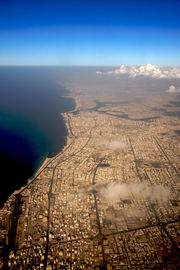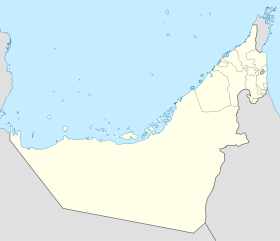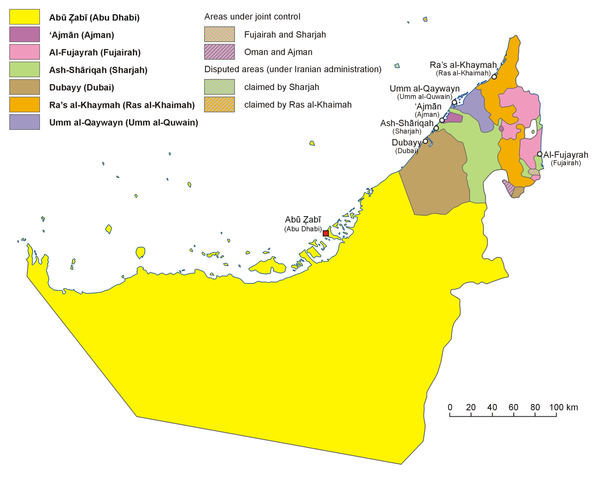Ajman
| Ajman إمارة عجمانّ |
|||
|---|---|---|---|
| — emirate — | |||
| Emirate of Ajman | |||
 |
|||
|
|||
 Ajman
|
|||
| Coordinates: | |||
| Country | United Arab Emirates (UAE) | ||
| Subdivisions | |||
| Government | |||
| - Type | Constitutional monarchy | ||
| - Emir | Humaid bin Rashid Al Nuaimi | ||
| Population (2008) | |||
| - Total | 361,160 | ||
| Time zone | UAE Standard Time (UTC+4) | ||
Ajmān (or Ujman; Arabic: عجمان ‘ajmān) is one of the seven emirates constituting the United Arab Emirates (UAE). With an area of just 260 square kilometres, Ajman is the smallest emirate by area. Its seat of government is Ajmān, which is bordered on its north, south, and east by Sharjah.[1]
Located along the Arab Gulf, Ajman also controls Masfut and Manama, two small, inland enclaves that are primarily agricultural. Approximately 95% of the population of the emirate resides in the city of Ajman. The population was only 36,000 in 1980 but grew considerably in recent years, due to an influx of people from the neighbouring emirates of Dubai, Sharjah, and other countries. Ajman is ruled by Humaid bin Rashid Al Nuaimi of the Al Nuaimi tribe. The Crown Prince of the Emirate is Sheikh Ammar bin Humaid Al Nuaimi. Ajmān has experienced massive development and a construction boom in recent years.[2]
Contents |
Etymology
Ajman is another word for a small city in Arabic .
History
On 8 January 1820, Sheikh Rashid ibn Humayd Al Nuaimi signed the General Maritime Treaty with Britain, accepting a protectorate to keep the Ottoman Turks out. Like four of Ajmān's neighbors, Sharjah, Dubai, Ras al-Khaimah and Umm al-Qaiwain, its position on the route to India made it important enough to be recognized as a salute state (albeit of the lowest class: 3 guns).
On 2 December 1971, Sheikh Rashid ibn Humayd Al Nuaimi joined the United Arab Emirates.
Its rulers were:
- 17.. – 17.. Sheikh Rashid ibn Hamid Al Nuaimi
- 17.. – 1816 Sheikh Humayd ibn Rashid Al Nuaimi
- 1816 – 1838 Sheikh Rashid II ibn Humayd Al Nuaimi (d. 1838)
- 1838 – 1841 Sheikh Humayd II ibn Rashid Al Nuaimi (1st time) (d. 1873)
- 1841 – 1848 Sheikh `Abd al–`Aziz I ibn Rashid Al Nuaimi (d. 1848)
- 1848 – 1873 Sheikh Humayd II ibn Rashid Al Nuaimi (2nd time)
- 1873 – April 1891 Sheikh Rashid III ibn Humaid Al Nuaimi (d. 1891)
- April 1891 – 8 July 1900 Sheikh Humaid III ibn Rashid Al Nuaimi (d. 1900)
- 8 July 1900 – February 1910 Sheikh `Abd al–`Aziz II ibn Humayd Al Nuaimi (b. 18.. – d. 1910)
- February 1910 – January 1928 Sheikh Humayd IV ibn `Abd al–`Aziz Al Nuaimi
- January 1928 – 6 September 1981 Sheikh Rashid IV ibn Humayd Al Nuaimi (b. 1904 – d. 1981)
- 6 September 1981 – 20.. Sheikh Humayd ibn Rashid Al Nuaimi (b. 1931)
Higher Education in Ajman
The Gulf Medical University (GMU), previously a college, became a university in July 2008 after an order issued by Shaikh Nahyan Bin Mubarak Al Nahyan, Minister of Higher Education and Scientific Research. This is the only institution with its own teaching hospital. Its Hospital Group is the largest healthcare provider in the UAE.[3]
Ajman development boom
After the success of freehold property in Dubai, Ajman was the second emirate to offer freehold property.[4] Ajman is currently the only emirate in the UAE offering investors of any nationality fully transparent true 100% freehold ownership on real estate, which in turn has attracted a huge number of investors (local and international) to this emirate. This in turn has prompted the Ajman government to initiate a number of development projects. New Ajman is the name given to the area being developed outside of the current Ajman city, located by the Emirates Road. New Ajman will consist of many new developments and projects envisioned by Chief of Municipality Sheikh Rashid Al Nuaimi. One of the first developments of New Ajman is called "The Emirates City", a brand new city located directly on the Emirates Road to be built from scratch and consisting of more than 100 mid- and high-rise buildings. A number of shopping malls, hotels and residential villas are also planned to eventually extend all the way to the 'Al Zoura' area, where beachside developments are planned.[5]
The construction of Ajman International Airport began in the second half of 2008 in the Al Manama area of the Ajman. Airport operations are scheduled to begin by 2011, and the airport is expected to host about two million passengers per year.[6][7][8][9][10][11][12][13]
List of planned developments
Following is a list of planned freehold developments in Ajman, although some real estate projects may be considerably delayed or cancelled, due to the financial crisis of 2007–2010.[14][15][16][17][18][19] That has also caused property prices to fall considerably throughout the United Arab Emirates, including in Ajman.[20]
- Ajman Green City
- Ajman One
- Ajman Marina
- Ajman Pearl
- Ajman Uptown
- Al Ameera Village
- Al Humaid City
- Al Ittihad Village
- Al Zorah
- Amber Islands[21]
- Aqua City
- Awali City
- Emirates City
- Emirates Lake Towers
- Escape Equestrian Community
- Eye of Ajman (Ain Ajman)
- Marmooka City
- Park View
Impact of visa regulation changes & the 2007–2010 financial crisis
Most if not all of these projects came to an abrupt stand still in 2008. Since then the foreign investors urge the Ajman government to return their investments. In contrary to Dubai investors, most Ajman investors come from the middle class of India, Pakistan or Iran. The apparent promise of a residence visa with the purchase of a home induced them to spend their life's savings on one of these off plan flats. In 2008 the central government of the UAE brought these hopes to an end by clarifying that no residence visas would be issued to property investors. With this announcement for a lot of these investors their investment dramatically lost value. This coupled with the global financial crisis and the rising doubts that Ajman will ever be able to provide these developments with water and power brought off plan property transactions to near zero.
In 2010 only Ajman Uptown and Emirates City have come out of the ground. The billboards along Emirates Road have removed, Emirates City became a ghost town before it ever got completed.
Ajman Real Estate Regulatory Agency
Transportation
The APTA chairman said there were 1,600 taxis operated by four companies in Ajman. The basic tariff is Dh3, during the day and evening base fare is at Dh3.50.[22]
Sports
Ajman Club is a football club based in Ajman.
See also
- List of Sunni Muslim dynasties
References
- ↑ Ajman (City and Emirate) - TEN Guide (UAE)
- ↑ Gulf News - Ajman now top target of property investors
- ↑ Medical university hails decade of success
- ↑ History of Freehold Property in the United Arab Emirates (Dubai) - TEN Real Estate
- ↑ AME Info - Middle East to be central link in world's first regional airport network
- ↑ Gulf News - Ajman to set up international airport
- ↑ Zawya - Ajman to build international airport
- ↑ AME Info - $3.3bn Ajman airport
- ↑ ArabianBusiness.com - Ajman airport construction to begin next year
- ↑ GoWealthy.com - Ajman to start operations of international airport by 2011
- ↑ Khaleej Times - Airport planned on outskirts of Ajman
- ↑ BreitBart.com - Ajman Ruler views the design of the proposed Ajman International Airport
- ↑ GulfNews.com - Ajman airport could handle 1m passengers by 2011
- ↑ TEN Real Estate [UAE] - List of developments Ajman Freehold Properties - Property Developments
- ↑ The National - Ajman continues with plans despite utility pressure
- ↑ The National - Property slowdown hits Ajman’s frontier
- ↑ The National - A forest of towers in Ajman is a lesson of how not to do it
- ↑ The National - Ajman, where trust in developers is at a premium
- ↑ The National - Worried investors in Ajman lobby ARRA
- ↑ Gulf News - Low rates make Ajman property attractive
- ↑ http://www.cwcgulf.com/amber_islands.htm
- ↑ Now Ajman Joins Sharjah in Hiking Taxi Fares
External links
- Ajman Government - Official website - Arabic
- Ajman Government - Official website - English
- Ajman travel guide from Wikitravel
|
|||||||

